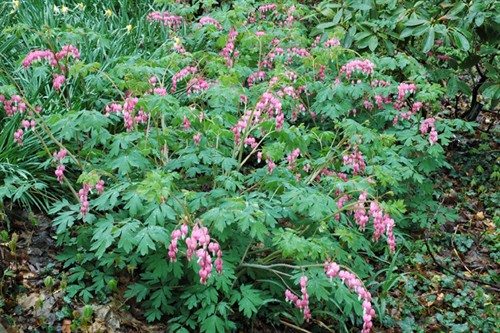Season finale has most impact
Although I've rather liked this warmer winter for a
change, what pluses and minuses can this mean for my perennial
flower garden and newly planted trees? - T.K. -
Ongoing discussion
at the Forum
No problem for hardy plants to slip a zone or two
A mild winter's no problem for plants so long as it doesn't
entirely deprive rest-dependent species of their time out. Many
plants geared to zone 5 winters can be fine in a zone 6 or 7 year,
where the coldest day is 10- or even 20 degrees warmer than it
could be.
What counts is the ticking clock
Plants need time at or below 40°F to acquire full hardiness and
remain dormant. Once top growth stops in late fall those with chill
requirements -- such as flower formation dependent on a certain
number of cold hours -- begin to tick off the time. They remain
"dormant" until they reach their species' target, which might be
500, 1,000, or even 1,500 hours at 40°F or less. There is no bonus
for extra cold. Every hour below 40°F counts, no matter how far
below that mark.

Racking up that time may take 3 -to 6 weeks in a real winter,
below 40°F 'round the clock. If days are warm so that only sunless
hours count, it may take 6- or 10 weeks. Either way, the need is
met and result's the same. What's different is that in the warmer
scenario a plant may come through with every branch tip, flower bud
and root intact, rather than losing bits to extreme cold.
Light sleepers most likely to run into trouble
Most hardy plants won't 'wake up' until they've had an extended
period at 50°F or warmer. If that warmth comes early, at the end of
winter when time's up, it can dissipate the blocks plants developed
during hardening in fall. Then plants' tips begin to grow, pulling
water up (the 'sap rises'). If it's too early, and frigid air
touches new growth that has no secondary freeze defense, it can be
a killer.
Yet that situation -- late warm-up followed by hard freeze --
can happen in any winter. Warm year or cold, unsettled springs
happen.

People say, "Old fashioned bleeding heart is so pretty, I
wish it would rebloom if we deadheaded it!" ButDicentra
sepctabilis can't help itself. After it blooms, it will rest,
and bloom-inhibiting chemicals within its cells will not wear off
until a winter's worth of cold hours pass.
Chill before
opening
Some species that require cold to bloom fully:
Common lilac (Syringa vulgaris and French
hybrids)*
Peony (Paeonia lactiflora, the common Memorial Day
peony)
Old fashioned bleeding heart (Dicentra spectabilis)
Apple/Crabapple (Malus species and hybrids)*
Tulip*
Daffodil
*If a species is marginal in your area because your winters are
too warm, check into varieties with lesser chilling
requirements.